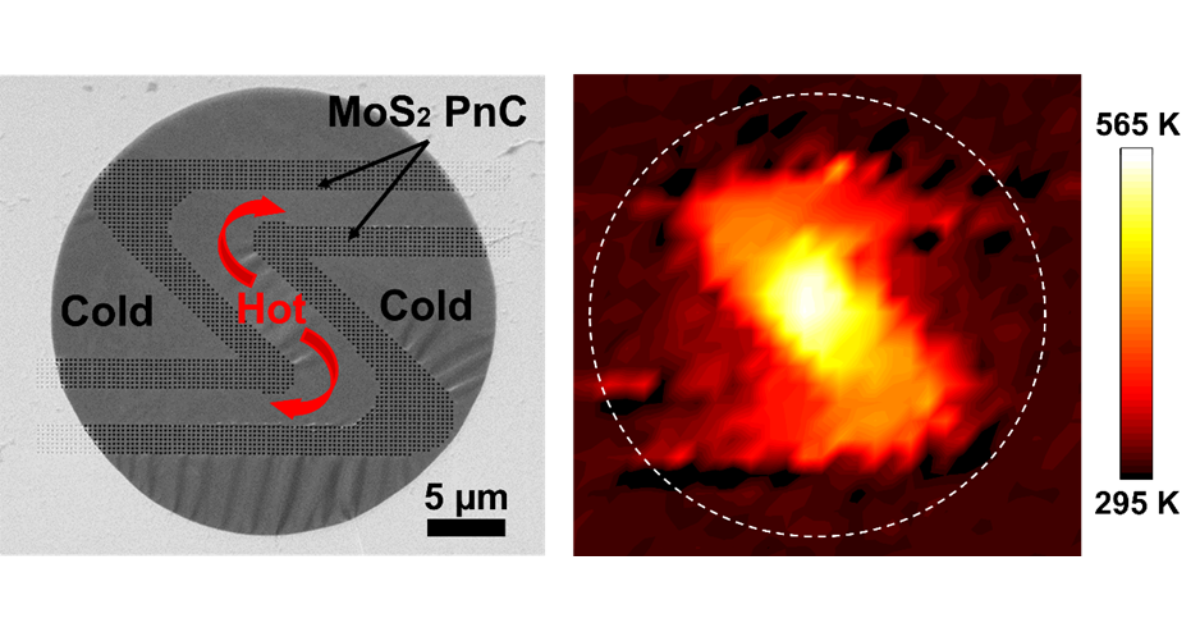Tuesday, 02 April 2024
Nano-Patterned 2D Materials Pave the Way for Cooler Electronics and Greener Energy Solutions
ICN2 researchers have achieved a significant breakthrough in materials science, developing advanced phononic crystals and heat guides with far-reaching applications for electronics cooling, energy efficiency, medical devices, and environmental conservation. Their study unveils a novel class of layered MoS2 phononic crystals that revolutionise heat management in unprecedented ways.

The innovative materials exhibit a remarkable ability to precisely direct heat flow, promising a new era of electronics that run cooler, more efficiently, and with longer lifespans. "Our findings open up incredible possibilities for managing heat in electronic devices, potentially overcoming one of the major challenges faced by the tech industry today", said Peng Xiao, one of the leading researchers.
Some of the authors of the research are members of the Thermal Properties of Nanoscale Materials Group (Marianna Sledzinska and Peng Xiao), led by UAB Prof. Javier Rodriguez-Viejo and the Atomic Manipulation and Spectroscopy Group (Emigdio Chavez-Angel), spearheaded by ICREA Prof. Aitor Mugarza. Their work is featured in the journal Science Advances and marks a significant advancement in materials science. Layered MoS2 phononic crystals offer a dual purpose: not only can they efficiently dissipate heat from sensitive electronic components, but they can also convert waste heat into electricity. This ICN2 study paves the way for a sustainable approach to energy harvesting across various applications. The versatility of these newly developed materials extends to the medical field, where they can be used to prevent overheating in devices, thereby enhancing patient safety and comfort.
A standout application of this technology is its potential to significantly improve the performance and energy efficiency of high-power electronics and computing devices, ranging from smartphones to supercomputers. "Imagine your electronic devices, no matter how much you use them, staying cool to the touch. This means they work better and last longer without the need for cooling systems that use a lot of energy", remarked one of the co-authors.
The ICN2 team also showcases the versatile application of MoS2 PnCs in building insulation, aerospace, automotive, and even in developing wearable health monitors. This highlights the broad influence of their research across various sectors. Moreover, integrating these materials into environmental sensors holds substantial environmental significance. They enable the monitoring of temperature fluctuations and thermal properties in both natural and urban settings, alongside tracking pollution levels. This contribution aids climate research and supports efforts to combat climate change.
This research was supported by the Severo Ochoa program, the Spanish Research Agency, and the CERCA Programme/Generalitat de Catalunya, among other contributors. The findings not only represent a leap forward in thermal management and materials science but also offer a glimpse into a future where technology and sustainability go hand in hand.
Reference article
Peng Xiao, Alexandros El Sachat, Emigdio Chávez Angel, Ryan C. Ng, Giorgos Nikoulis, Joseph Kioseoglou, Konstantinos Termentzidis, Clivia M. Sotomayor Torres & Marianna Sledzinska (2024). MoS2 phononic crystals for advanced thermal management. Science Advances, 10. DOI: 10.1126/sciadv.adm8825

